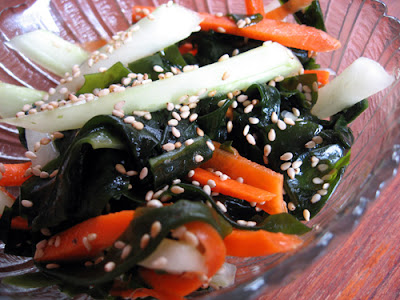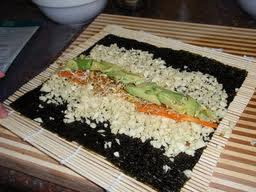I've had a great but very busy week (weekend) and I hope you are off to a great week too. I have a lot on my plate (pun intended), but I am always looking for new foods and dishes I can make at home to control the qulaity and maintain the nutritional impact of my foods. Something I have been eating these for years in different formats and I'm excited to tell you about sea veggies, that's right, vegeatables from the ocean. Don't lose it here, hold on, just keep reading and I know you will want to try some for yourself after reading how good they are for you. It is my hope you will give them a try and if you already enjoy them, let me know you how you eat them and maybe we can put an article about your sea veggie experiences/recipes!
Sea vegetables are some of the highest in nutrients and yet, many of us don’t eat them and think they are gross because they lived in the sea! They are rich in anti-allergy and anti-inflammatory algae that also boost our immunity. You might not know that even in prehistoric times it was a staple for our ancestors. Sushi is what comes to mind for most when they think of seaweed (nori sheet) but sea vegetables are far from our mainstream diet.
In a study from the journal Nutrition Reviews, sea vegetables are high in essential vitamins, minerals that if consumed regularly would be more than enough for anyone. In fact the micronutrients levels in marine plants are higher many land based foods like brown rice, lentils, many fruits and vegetables. The calcium levels are higher as well as, iron and copper than in meat and spinach! These plants from the sea also provide potassium, magnesium, iodine and high levels of protein. These same veggies have omega-3 fatty acids and vitamins A, B, C and E. Plus the fiber they offer is close to 12.5% of the daily recommended amount. That is amazing what these plants offer and yet we are skittish to eat them, why? Because they are from the sea and our mothers didn’t teach us to like them because she didn’t know. You can change that right now!

Another amazing fact is these sea veggies are low in calories and fat! That’s why these plants have been found to fight off viruses and cancers. Some studies indicate these plants can lower cholesterol and blood pressure as well as being a super immunity food, which is why we should eat them regularly if not daily. We have close to 10,000 species of marine plants that offer up their own unique nutritional advantages. Let me go over a few of the more common ones you can find in health food store and in local markets:
Arame, this is kelp that has a thin texture with a nutty taste that is rich in calcium, iron and iodine. It’s a good addition to beans, grains, noodles, stews and casseroles.
Dulse, is a red leaf veggie that has a smoky flavor and is easy to eat right out of the bag and has the most iron of all the sea veggies. Kacie Loparto fries it up like bacon. It can be a good addition to any salad but if it is cooked too long it deteriorate because it is a delicate plant.
Nori, is used to make sushi rolls and is the most common in the U.S., which also has the highest levels of protein. The flavor is sweet and meaty. I use it for soups and as a snack.
Wakame, is one of my favorite green veggie because of its mild flavor and I love seaweed salad. I will provide a recipe at the end for you to try on your own. This kelp needs soaking or a little heat if you prefer to reconstitute it but be aware it expands once soaked and you have more on your hands than just a little. I have found that many of these sea veggies are dehydrated for longer shelf life and to keep them fresher for us.
If you are bored with the same ol, same ol, then this is a good alternative to spinach, broccoli and the same old lettuce mixture you might be used to. I love to use it in salads for a flavor that is so different that I can’t believe I didn’t try it long before I did. The benefits are fantastic and it is versatile enough to use in many forms and I suggest you experiment. Anyone who knows me knows I like to experiment and to see what combinations I can find to make a new dish. For me, this is part of the journey, to explore new areas and find new things to eat. This past weekend I found nori sheets made with wasabi as a snack and I was addicted after the first bite! The wasabi burn along with the crunch of the nori sheet was incredible.
Bill’s seaweed salad:
- I use 2-3 wakame pieces (about ¾ oz.) soaked and/or slightly heated up. Put on a paper towel to drain the moisture away. I usually let them set for 5-10 minutes. While that is drying I mix together:
- 3 tbsp. rice wine vinegar
- 1 tbsp. sesame oil
- 1 tbsp. soy sauce
- 1 tsp. sugar
- 1 tsp. ground toasted sesame seeds (white are more pure)
- Hot chili flakes to taste, but don’t be afraid to add them for that additional spice.
Next, put the dried seaweed into a bowl or mixing container and add the mixture from above, stir thoroughly for a rich flavored salad that tastes as good as what you might expect in the restaurant. Sometimes I add in cut cucumbers or chopped onions, mushrooms, tofu, you can add what you like and the flavor just keeps getting better. My mouth is beginning to water thinking about this.
Analysis per ¾ cup serving: 73 calories, 6g proteins, 2 g fat (none is saturated), 1g fiber, 8g carbs, 620mg sodium.
You can do this! Tastes great and is even better for you. Try this as a way to spice up your meals and what you eat through out the week. There are many marine plants that we can enjoy and I like variety so I look around at what foods I can get my hands on for a new treat. This will be your new go-to food.
To your health,
Bill












